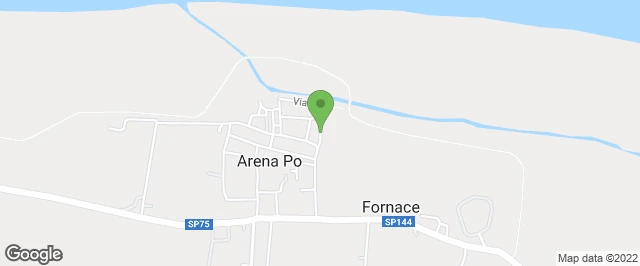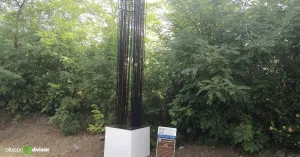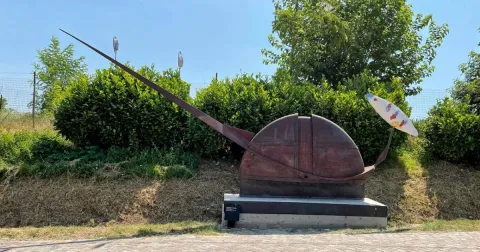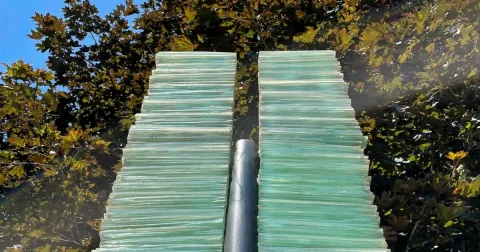UNA QUOTIDIANA TENSIONE SOSPESA - ALDO IORI
Nel lavoro artistico di Renzogallo degli ultimi anni si nota una sempre più crescente interesse alle caratteristiche spaziotemporali dell’opera, al richiamo a forme di vasto e antico respiro e al superamento della dimensione materica a favore di quella metafisica. Questa attenzione, già indubbiamente individuabile in tutta la sua opera fin dalla serie delle Porte dei primissimi anni ottanta, è dovuta a diversi fattori, intimamente interconnessi, frutto di nuove riflessioni e di particolari esperienze vissute.
In primo luogo la propensione per la dimensione speculativa del lavoro ha condotto Renzogallo a percorrere vie e approfondimenti nel campo delle discipline filosofiche e meditative mediante la letteratura, la poesia o esperienze dirette di persone e luoghi. Il lavoro risulta arricchito di echi di lontane culture che si combinano con le già presenti e forti radici mediterranee. Le opere di Renzogallo hanno sempre richiesto una intensa partecipazione dell’osservatore e oggi lo invitano ad affinare lo sguardo su di esse rivelando di volta in volta differenti suggestioni che richiamano il profondo e l’arcaico e si intessono con idealità di matrice classica. La matura consapevolezza dell’artista e la sua consolidata maestria nel dominio della composizione e dei materiali forniscono risposta alla sempre inderogabile e intima necessità di dare forma, con materie lavorate, manipolate o assunte direttamente dal reale, a qualcosa sempre sul confine tra ciò che è e ciò che, pur non percepibile dall’occhio, si dischiude alla mente dell’osservatore.
Nelle opere degli anni più lontani il valore simbolico e la sospensione spaziale delle forme, la coniugazione dei materiali e il predominio di specifiche cromie e rapporti compositivi mostravano già la presenza di una tensione verso la dimensione immateriale che l’immanenza della realtà o gli schemi estetici e ideologici, che l’arte allora necessitava, velavano e rendevano più nascosta. Oggi la tendenza a privilegiare la dimensione speculativa sopra citata, la precisione del gesto, l’accuratezza nella scelta e nella lavorazione dei materiali, il processo elaborativo reso ancor più armonico si riflettono in una maggiore serenità dell’opera nel dischiudere il momento epifanico senza alcuna facile meraviglia. Questo contrasta con la consuetudine contemporanea a porre in primo piano il clamore piuttosto che il silenzio, segnando una giusta controtendenza dell’artista che lo pone in linea e in assonanza con il solido percorso storico nel quale egli è sempre fortemente ancorato e inserito.
Un secondo fattore che si accompagna al primo è la riflessione che Renzogallo attua sulla dimensione storica delle arti plastiche e pittoriche. Gli elementi messi in gioco, più di prima, hanno riferimenti con l’identità del comporre la forma che spazia dall’antichità alle esperienze dei maestri dell’ultimo secolo. Alcuni elementi, come il vaso e la grata, sono assunti fin dal loro primo apparire nel suo lavoro, con tutte le valenze acquisite nel corso della storia, come fattori archetipici, antropologici, come cardini del rapporto tra pieno e vuoto. Anche le opere più bidimensionali, ma dalla forte componente spaziale, sono ricche di richiami alla lezione della grande pittura, nella scelta dei cromatismi, nella stesura dei pigmenti, nella giustapposizione delle parti o semplicemente nell’evocare climi iconografici o soluzioni che forniscono vitalità ed energia alla composizione. La scelta di matrici geometriche, semplici o composte, si accompagna al superamento del momento razionale e progettuale per evocare proporzionalità auree in sintonia con le esperienze del passato come con quelle recenti di tutto il secolo scorso, da Klee a Burri, dal Razionalismo architettonico alle esperienze post minimaliste.
Ulteriori elementi da sottolineare sono l’esperienza dovuta alla progettazione e alla realizzazione di opere dalla dimensione ambientale, collocate in luoghi naturali e urbani, e parallelamente l’impegno didattico a cui l’artista è stato chiamato in campo universitario; entrambi lo hanno avvicinato maggiormente alle problematiche proprie dell’architettura e alla dimensione naturale, arricchendo il lavoro di nuove cognizioni e interessi. L’opera si pone come luogo ove si stabilisce il rapporto tra pensiero e paesaggio nello scorrere del tempo in ciclici avanzamenti.
BIOGRAFIA
Nasce a Roma il 24 gennaio 1943.
Compie studi artistici (Liceo e Accademia) con docenti come Giuseppe Capogrossi e Giulio Turcato, Afro e Gastone Novelli.
Nel 1964 vince un concorso per un Borsa di Studio di Scambi Culturali del Ministero degli Affari Esteri e della Pubblica Istruzione da usufruire in Spagna, per continuare gli studi all’Accademia di Belle Arti “San Fernando” di Madrid. In quest’anno realizza la sua prima mostra personale alla “Residencia de Relaciones Culturales” di Madrid. Si trasferisce quindi a Barcellona dove frequenta molti artisti ed intellettuali che operano in questa città. Qui realizza la sua prima installazione polimaterica presso il Centro Jazz “Jamboree” (metri 18 x 2). Successivamente si trasferisce a Parigi dove compie studi di architettura e design.
Rientrato in Italia, il Maestro Gastone Novelli lo presenta alla Galleria “Il ferro di cavallo” dove realizza la sua prima personale italiana nel 1967. In questo periodo si interessa di architettura e di teatro d’avanguardia.
Nel 1969, per realizzare una sua opera teatrale e fonda un gruppo (Gruppo IMMAGINE) e debutta al Teatro BEAT 72 di Roma occupandosi di Teatro sperimentale e coniugando arti visive con azione teatrale. Nello stesso anno vince un Concorso per la docenza di Discipline Pittoriche al Liceo Artistico di Latina. Proseguirà la docenza successivamente al I° Liceo artistico di Roma fino al 1997.
Dopo l’esperienza teatrale del 1967 e 68, concentra tutta la sua attenzione sul significato della pittura e dello spazio e orienta la sua ricerca su una minimale struttura a maglia quadra con varianti segniche e minime grammature di colore. Il suo lavoro si caratterizza, quindi, con l’utilizzo di molti materiali diversi che dalla superficie si estendono nell’ambiente. Dal 1976 inizia a realizzare installazioni.
Dal 1985, anno in cui assume il nome d’Arte “RENZOGALLO”, si occupa totalmente di grandi sculture, installazioni e grandi opere ambientali in cui entrano componenti eterogenee quali carte-riso, argilla, legno, reti metalliche, vetri, cavi in acciaio ecc. Nel 1986, insieme ad alcuni artisti, collezionisti e intellettuali fonda la Galleria “ARCO DI RAB” a Roma.
Ha realizzato varie Opere Pubbliche in Italia e all’estero. Il suo lavoro si svolge in molti paesi dove, generalmente, realizza le proprie opere con maestranze locali e dirige work-shop e tiene conferenze. Sue opere sono presenti in vari Musei italiani ed esteri.
Dal 2005 e 2006 è Docente di “Forme e strutture dello Spazio” , titolare del laboratorio “Plastica ornamentale e Artistica”, nella facoltà di Architettura di Valle Giulia dell’Università LA SAPIENZA di Roma.
Dal 2006 e 2007, 2008 è Docente di Progettazione artistica per l’Ambiente e il Paesaggio presso il Corso di Laurea PROGETTAZIONE E GESTIONE DELL’AMBIENTE della Facoltà di Architettura Valle Giulia della SAPIENZA e Facoltà di Agraria dell’Università della Tuscia.
Nel 2006 è stato invitato dall’Università di Salonicco (Grecia) come Oratore e PRINCIPAL SPEAKER in un convegno internazionale sulla “TRASPARENZA” in Arte e in Architettura. Continuerà la docenza alla Facoltà di architettura nel Dottorato di ricerca fino al 2017.
Nel 2008 è nominato membro della giuria per il Premio internazionale di scultura Ambientale del CHACO nella città di Resistencia in Argentina e invitato a tenere una conferenza sul proprio lavoro all’Accademia Nazionale di Buenos Aires.
Nello stesso anno si reca a Tokyo per un Convegno presso l’Istituto Italiano di Cultura dove presenta un suo intervento dal titolo: “Arte come costruzione di senso”. Dal 2007 fino ad oggi tiene il Corso di FORME DELL’ARTE IN FORME DELL’ARCHITETTURA nel Master di Allestimento e Progettazione di Componenti che si tiene annualmente nella Facoltà di Architettura dell’Università LA SAPIENZA.
Dal 2010 al 2017 fa parte in qualità di esperto, nel Collegio Docenti del Dottorato di Ricerca di Progettazione dell’Ambiente e del Paesaggio del Dipartimento di Architettura e Progetto dell’Università di Roma La SAPIENZA.
Nel 2013 e 2014 è chiamato per chiara fama dall’Accademia di Belle Arti di Perugia Pietro Vannucci come titolare del Biennio di specializzazione del laboratorio di Pittura.
La sua produzione artistica si realizza, inoltre, con una notevole attività espositiva in gallerie d’Arte e Musei italiani e esteri, convegni, work-shop. Realizza numerose Opere pubbliche in Italia e in vari paesi europei.
Oltre all’italiano parla correntemente lo spagnolo e il francese. Vive e lavora a Roma e in Umbria.
Ovunque, guardando - Renzogallo
L'opera esposta al MAAAPO di Arena Po è stata realizzata dall'artista Renzogallo.
Galleria Fotografica
Descrizione articolo
[Per segnalare eventuali refusi/errori usa la form di contatto. Grazie per la collaborazione.]
Luoghi di interesse
La pagina in cui ti trovi rappresenta un luogo di interesse appartenente ad un itinerario, clicca qui per vederlo completo
Prosegui la scoperta del territorio attraverso i nostri itinerari, clicca qui per vederli tutti
Prosegui la scoperta del territorio attraverso i nostri itinerari, clicca qui per vederli tutti
Luogo successivo dell'itinerario
Etruria - Antonio Ievolella
L'opera, esposta al MAAAPO di Arena Po, è stata realizzata dall'artista Antonio Ievolella.
Mostra percorso
Luogo precedente dell'itinerario
Senza Titolo - Costas Varotsos
L'opera esposta al MAAAPO di Arena Po è stata realizzata dall'artista Costas Varotsos.
Mostra percorso
Percorsi Tematici
I Percorsi Tematici: un insieme di contenuti accomunati tra loro da un tema per andare alla scoperta di un territorio con un sistema di suggerimenti a portata di mano!
Data di pubblicazione
17.03.2022




